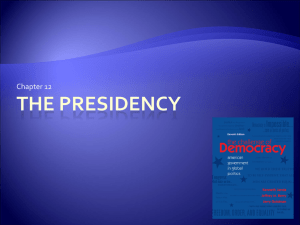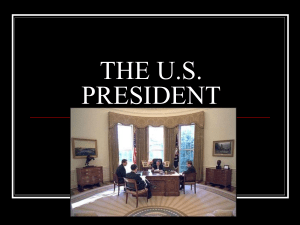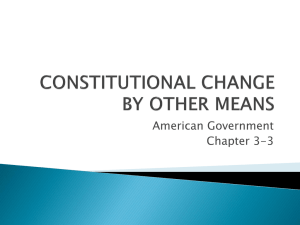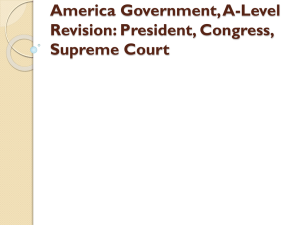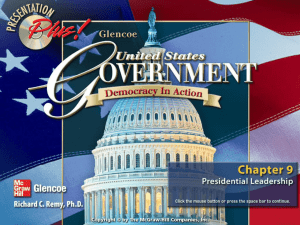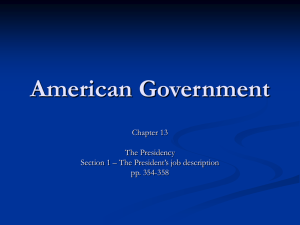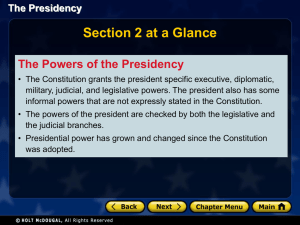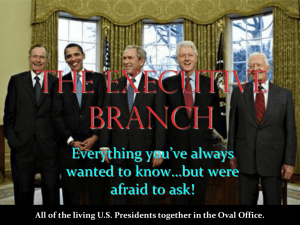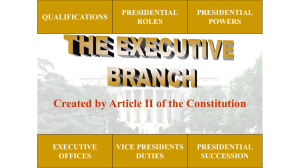chapter 13
advertisement
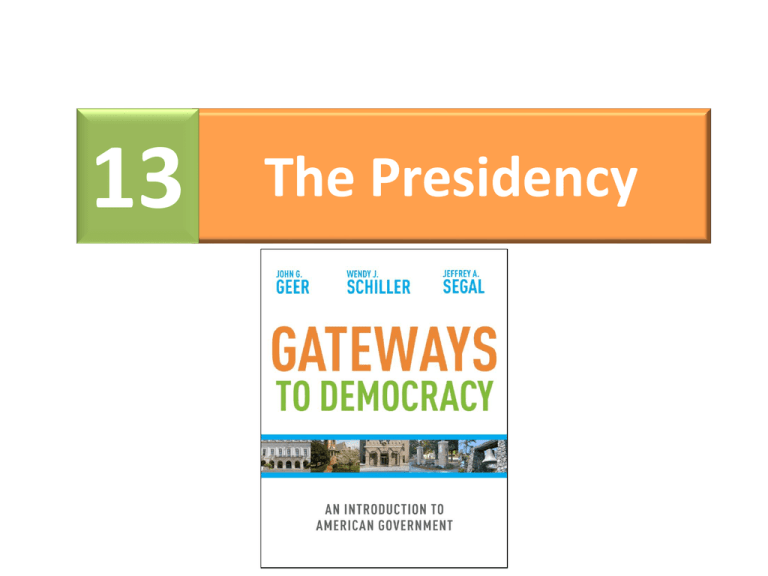
13 The Presidency The Presidency Presidential Qualifications • Article II, Section 1 of the Constitution states that the president must be: – a natural-born citizen (or a citizen at the time the Constitution was adopted) – at least 35 years old – a resident of the United States for at least fourteen years Qualifications for the Vice Presidency The original Constitution did not specify eligibility for the vice presidency, as the person who came in second in the vote for president would be vice president. • The Twelfth Amendment, ratified in 1804, changed the process so that candidates are elected for president and vice president separately. - The amendment also specifies that vice presidents must meet the same eligibility requirements as presidents and that they be from different states. Presidential Succession The Constitution also states that when the president is removed from office, by death, resignation, or inability to perform the duties of the office, the vice president becomes president. • In 1792, Congress passed the Presidential Succession Act, which designated the president pro tempore of the Senate as next in line, and then the Speaker of the House. • In 1886, Congress changed the order of succession to include only cabinet secretaries in order of their creation. • In 1947, Congress changed presidential succession once again, putting the order of succession as vice president, Speaker of the House, president pro tempore, followed by the cabinet secretaries. Vacancies in the Office of the Vice President There was no actual constitutional provision for replacement of the vice president, and in the course of the nation’s history the office was occasionally vacant. • The Twenty-Fifth Amendment, ratified in 1967, required the president to nominate a replacement vice president, who must be approved by a majority vote of the House and the Senate. – Gerald Ford Presidential Term Limits For a century and a half, presidents followed the precedent established by George Washington when he stepped down after two terms. • President Franklin D. Roosevelt was elected to four terms. • The Twenty-Second Amendment (1951), limits the president to two elected terms. Background and Experience The clearest path to the White House is through the office of the vice president, but most presidents have some combination of service in the military, in state legislatures or as governor, in the U.S. House of Representatives and Senate, and in prior presidential administrations. • The No Religious Test Clause of the United States Constitution is found in Article VI, paragraph 3. – No religious test shall ever be required as a qualification to any office or public trust under the United States. The States Where Presidents Were Born The Expansion of the Presidency The Constitution did not grant the office of president too much in the way of unchecked powers. However, as the power of the country grew so too did the power of the presidency. • The historian and presidential adviser Arthur Schlesinger Jr. used the term “imperial presidency” to describe the power of the president to speak for the nation on the world stage and to set the policy agenda at home. Presidential Power The Framers expected that the executive branch would be smaller and less powerful and did not believe it was necessary to enumerate the executive powers as they did with the legislative powers. • In Article II, they “vested” the president with a general grant of “executive power” and then, later in the article, stated certain additional powers and responsibilities of the executive. – It is this general grant of executive power that has allowed the presidency to become the powerful office it is today. Comparison of Legislative and Executive Authority under the Constitution Commander in Chief The president is the commander in chief of the armed forces of the United States. • The president directs all war efforts and military conflict. • Congress, however, has the power to officially declare war and to authorize funding for the war effort. Power to Pardon The president has the power to grant clemency, or mercy, for crimes against the United States, except in the case of impeachment from federal office. • For example, in his last year in office, President George W. Bush issued seventy-six pardons and commuted seven sentences, including one for a former White House staff member, I. Lewis “Scooter” Libby. • The Power to Pardon is the only “unchecked” power the President is constitutionally given. Treaties and Recognition of Foreign Nations • The president’s authority in foreign affairs includes the power to “receive Ambassadors and other public Ministers,” which allows the president to recognize the legitimacy of foreign regimes. • The president or his designated representative has the power to negotiate and sign treaties with foreign nations. - For a treaty to be valid, two-thirds of all senators must approve it. Appointments and Judicial Nominations The president has the power to appoint all federal officers, including cabinet secretaries, heads of independent agencies, and ambassadors. The president also nominates judges in the federal judicial system • Must be approved by the Senate. – Recess appointments may be made when the Senate is not in session. This has become a tool for Presidents to push through nominees who had been filibustered in the Senate. – The president has the power to fire federal officers, but not to remove judges, who can be removed only by impeachment. Veto and the Veto Override The President has the power to veto bills passed by Congress before they become law, by refusing to sign them and sending them back to the chamber in which they originated, with his objections. • If Congress will be going out of session within ten days, he can simply not sign the bill, a practice known as a pocket veto. • In cases where the president refuses to sign the bill but Congress remains in session, the bill is enacted into law. - To counter the power of the veto, the Framers gave Congress the veto override, the power to overturn a presidential veto with a two-thirds vote in each chamber. Veto and the Veto Override The President has the power to veto bills passed by Congress before they become law, by refusing to sign them and sending them back to the chamber in which they originated, with his objections. • If Congress will be going out of session within ten days, he can simply not sign the bill, a practice known as a pocket veto. • In cases where the president refuses to sign the bill but Congress remains in session, the bill is enacted into law. - To counter the power of the veto, the Framers gave Congress the veto override, the power to overturn a presidential veto with a two-thirds vote in each chamber. Presidential Vetoes Presidential Vetoes Continued Other Powers The president works within this framework of formal powers and constraints to lead the nation, and in doing so, becomes the chief agenda setter for domestic and foreign policy. • One tool is the State of the Union address. – Over the last century, presidents have turned this obligation into an opportunity to outline a broad policy agenda for the nation. Impeachment and Censure Congress’s ultimate check on the executive and judicial branches is its power to remove officials and judges from office by impeachment and censure. • The president, vice president, and high officials are subject to impeachment for “Treason, Bribery, or other high Crimes and Misdemeanors.” Impeachment and Censure The process takes place in two steps. • First, a majority of the House of Representatives votes to bring formal charges against the president. • Then the Senate conducts the trial, with the chief justice presiding. - Only 2 presidents have been impeached, Andrew Johnson and William Jefferson Clinton. Neither were censured. - President Nixon faced impeachment, but resigned before the proceedings were complete. The Growth of Executive Influence Presidents use the executive power to issue presidential directives that give specific instructions on a federal policy that do not require congressional approval. • Executive Orders • Proclamations • Military orders – Repeal of Don’t Ask, Don’t Tell Executive Orders The most well-known type of directive is the executive order, which can be used for a wide range of purposes. • Executive orders instruct federal employees to take a specific action or implement a policy in a particular way. – In 1948, President Harry Truman integrated the armed forces with Executive Order 998. – President Dwight D. Eisenhower used a combination of executive orders, proclamations, and military orders to enforce school integration in Little Rock, Arkansas. Presidential Directives on National Security In foreign and military affairs, presidents can issue presidential directives on national security, which have a similar purpose to executive orders. • These directives can announce specific sanctions against individuals who are considered enemies of the United States or make larger statements about U.S. policy toward a foreign country. • President George W. Bush used this power frequently. – In 2001 to create military tribunals that would try suspected enemy combatants and terrorists, rather than allowing them to be tried in a regular military court. Signing Statements When a president signs a bill into law, he can issue signing statements, written remarks that reflect his interpretation of the law. • Signing statements can be classified as nonconstitutional and constitutional. – Non-constitutional statements are symbolic, celebrating the passage of the law or providing technical instructions. – Constitutional statements are used to indicate a disagreement with Congress on specific provisions in the bill. • May go so far as to say the President refuses to implement specific provisions of a bill. Presidential Signing Statements Power to Persuade Presidents understand that communicating well with the public is essential to building support for their policies. • Bully Pulpit – Where presidents could use the attention associated with the office to make a public argument in favor or against a policy. – Press conferences are one important way of sustaining a relationship with the media and presidents have tried to use them to their advantage. Factors Affecting Presidential Persuasion Several factors affect a president’s power to persuade. • Approval Ratings - Lawmakers are more likely to pass a president’s policy proposal when his approval rating is high, and they are less cooperative when the president is unpopular. Agenda Setting Presidential Singularity • In dealing with foreign powers, the president is head of state and commander in chief. • As head of state, the president oversees a vast organization of employees in the State Department and the office of the U.S. Trade Representative who lay the groundwork for negotiations with foreign leaders on issues ranging from nuclear weapons control to trade policy. • The president is the public face, and authority, behind U.S. foreign policy decisions. Agenda Setting continued In the area of domestic policy, the president uses the following tools to advance his agenda: • State of the Union address • Federal budget • Executive appointments • The bully pulpit • Executive power to implement laws • Veto power • Propose laws Federal Budget The president issues his federal budget in early February, shortly after he delivers the State of the Union address. • It is a blueprint that indicates his spending priorities for all areas of the federal government. - Congress is not bound by the President’s budget, but he can veto the budget they pass so it is a tool of negotiation. The War Powers Act The War Powers Act states that the president cannot send troops into military conflict for more than ninety days without seeking a formal declaration of war from Congress. • Designed to limit the power of the President to act militarily without Congressional Approval. – A president could send troops into a conflict and simply not report it to Congress, thereby avoiding a trigger of the War Powers Act. – The act did not really give Congress the power to end a military conflict except by denying all funding for it. – Iraq and Afghanistan Power Struggles between the President and the Judiciary Power struggles between the president and the judiciary in wartime generally focus on civil liberties. • The most recent clashes between the president and the judiciary over wartime powers arose during President George W. Bush’s declared “war on terror.” – Military tribunals and exemption from Geneva Convention – Hamdi v. the United States • Rejected Bush administration attempts to deny habeas corpus to an enemy combatant who was a U.S. citizen. • Court also extended habeas corpus protections to enemy combatants who were NOT U.S. citizens. The EOP continued The growth of the Executive Office in the past seventy-five years is stunning. • President Franklin Delano Roosevelt had only sixty employees; President George W. Bush had more than 5,000 people working directly or indirectly for him. Presidential Greatness In order for Presidents to be great they need three things: • Will • Skill • Opportunity Franklin Delano Roosevelt Franklin Delano Roosevelt To combat the effects of the depression, FDR had a clear policy vision, which he called the New Deal. He got Congress to pass legislation that radically altered the size and shape of the federal government. • Expanded the government’s role in regulating the economy. – Securities and Exchange Commission – National Labor Relations Act – Social Security • Used the bully pulpit • Fireside Chats Lyndon Baines Johnson Lyndon Baines Johnson President Lyndon Johnson (LBJ) focused his mission on improving race relations and ending poverty. • The Great Society – Civil Rights Act of 1964 – Voting Rights Act of 1965 – Fair Housing Act of 1968 – Medicare and Medicaid – Food Stamp Program – School Lunch Program – Head Start – Jobs Corps – Elementary and Secondary Education Act. Ronald Reagan Ronald Reagan Tax cuts were the first thing on Reagan’s agenda. • He reasoned that if taxes went down, the economy would flourish. - Supply side economics • He knew that if tax revenue went down, and spending increased, federal budget deficits would be created. - These deficits would give him justification for proposing cuts in entitlement programs. • He took a firm stand against the Soviet Union. • “Great Communicator” Focus Questions • In what ways is the president held accountable, both individually and for the collective economic, military, and social condition of the federal government? • How responsive is the presidency as a democratic office? How can the president address the vital public policy concerns of the American people? • What opportunities are there for the average person to influence the decisions of the president? • What powers does the president have to ensure equality across all citizens? • Is the modern presidency a gate, or a gateway, to democracy?


